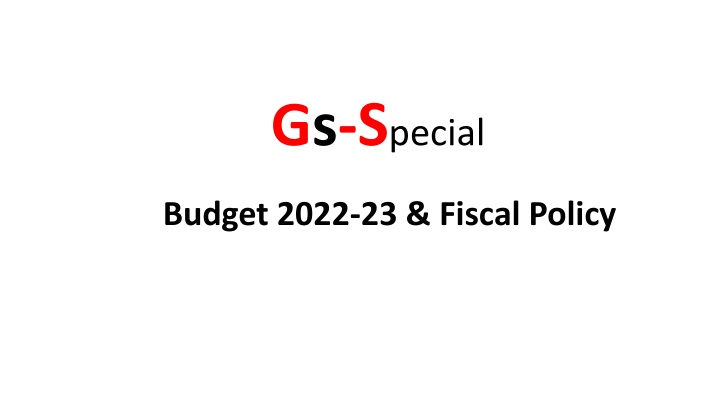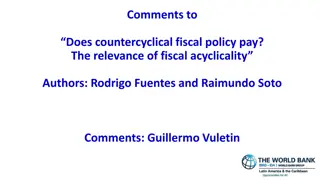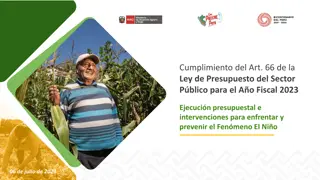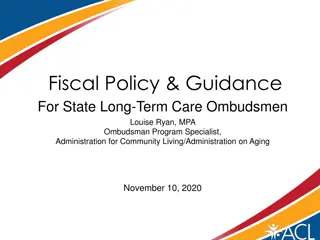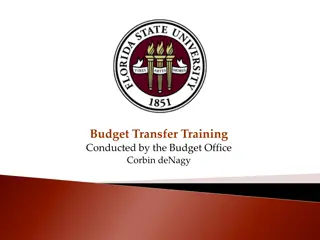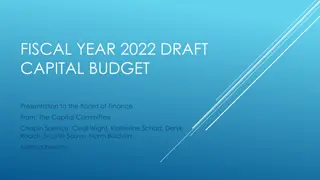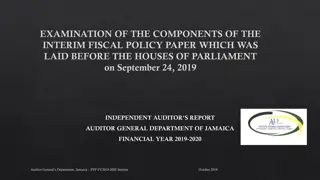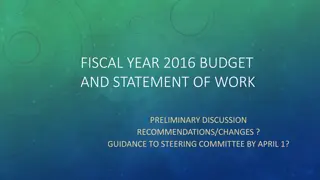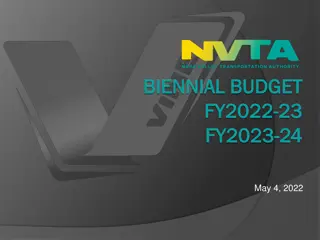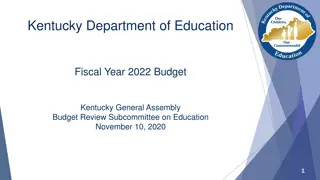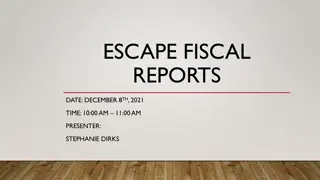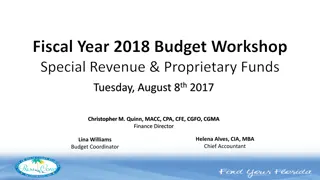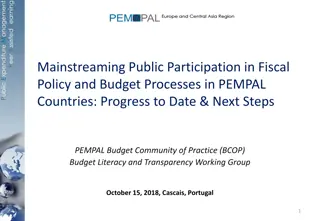Gs-Special Budget 2022-23 & Fiscal Policy Overview
This content provides insights into the preparation of the budget, the importance of studying it, and how to analyze budgetary information effectively. It covers economic forecasts, revenue projections, expenditure planning, fiscal policy cues, and more.
Download Presentation

Please find below an Image/Link to download the presentation.
The content on the website is provided AS IS for your information and personal use only. It may not be sold, licensed, or shared on other websites without obtaining consent from the author.If you encounter any issues during the download, it is possible that the publisher has removed the file from their server.
You are allowed to download the files provided on this website for personal or commercial use, subject to the condition that they are used lawfully. All files are the property of their respective owners.
The content on the website is provided AS IS for your information and personal use only. It may not be sold, licensed, or shared on other websites without obtaining consent from the author.
E N D
Presentation Transcript
Gs-Special Budget 2022-23 & Fiscal Policy
How is budget prepared? Economic forecast is prepared through data collection According to economic forecast and current revenue collection, a revenue projection is made A requirement estimate is prepared through forms and circulars Then accordingly an expenditure plan is made and provisions are made for gap (Done through data collection during 2nd and 3rd quarter) Deficit is targeted and a rough financing plan is made and is executed through out the year as per requirement
Why do we study budget? The media analyses the budget from perspective of personal finance as in what became expensive and what cheaper; what is the impact on tax burden and savings, etc; but the UPSC exam approaches budget in a very different way and we need to understand the following: which direction this budget will take us in future? Is it addressing the most pressing concerns of the country? Whether this budget maintains balance between stability and growth or is it tilted in any particular direction? Is there any landmark scheme or a major flagship program launched in it? Never are questions asked on budgetary numbers and taxes and Never do we ask questions regarding income taxes and impact on savings etc.
How to analyze Budget? Identify the break-up of revenue projection (just the trends, not numbers) Check-out for break-up of expenditure plan (just the trends, not numbers) Identify the Capital Expenditure details (just the trends, not numbers) Details on social sector spending Is there any landmark scheme? To identify the fiscal policy cues from the budget Is there any fiscal consolidation to control deficit? Is there any increase in tax incentives to encourage growth?
Break-up of Revenue Tax Revenue 58% Custom 5% Union Excise Duty 7% Corporation Tax 15% Income Tax 15% GST 16% Non-Tax revenue 5% Borrowing and Liability 35% Non Debt Capital receipt 2%
Break-up of Expenditure Interest Payments 20% State share of taxes 17% Central Sector Scheme 15% Finance Commission and other Transfers 10% CSS 9% Subsidy 8% Defence 8% Pensions 4% Other Expenditures 9%
Central Sector Scheme vs Centre Sponsored Scheme Central Sector Schemes They are the schemes that are entirely and directly funded and executed by the central government. The schemes are formulated by the Centre, based on subjects from the Union List. Besides, there are some other programs that various Central Ministries implements directly in States and UTs which also comes under Central Sector Schemes. In these schemes, the financial resources are not shifted to states. Examples of Central Sector Scheme Some examples of Central Sector Schemes include Bharat-net, Namami Gange (National Ganga Plan), PM-ujwalla, Pradhan Mantri Mudra Yojana and other credit guarantee funds, etc. Central Sponsored Schemes Centrally Sponsored Schemes on the other hand are schemes that are implemented by state governments. However, the cost of these schemes is borne on a shared basis in the ratio of 50:50, 70:30, 75:25 or 90:10. Under the cost ratio, the larger portion is always borne by the Centre. CSS is a system under which the centre assists the state government financially to get schemes implemented.
Expenditure Trends Expenses which bring a change to the government s assets or liabilities (such as construction of roads or recovery of loans) are capital expenses, and all other expenses are revenue expenses (such as payment of salaries or interest payments). In 2022-23, capital expenditure is expected to increase by 24.5% over the revised estimates of 2021-22, to Rs 7,50,246 crore. Revenue expenditure is expected to increase by 0.9% over the revised estimates of 2021-22 to Rs 31,94,663 crore.
Total Receipts: Government receipts (excluding borrowings) are estimated to be Rs 22,83,713 crore, an increase of 4.8% over the revised estimates of 2021-22. Receipts Trends Gross tax revenue is budgeted to increase by 9.6% over the revised estimates of 2021-22, which is lower than the estimated nominal GDP growth of 11.1% in 2022-23. This is mainly on account of a 15% decrease in excise duties. Other taxes are estimated to rise faster than nominal GDP. The net tax revenue of the central government (excluding states share in taxes) is estimated to be Rs 19,34,771 crore in 2022-23. Non-tax revenue is expected to be Rs 2,69,651 crore in 2022-23. This is 14.1% lower than the revised estimate of 2021-22. Capital receipts (without borrowings) are budgeted to decrease by 20.7% over the revised estimates of 2021- 22. This is on account of disinvestments, which are expected to be Rs 65,000 crore in 2022-23, as compared to Rs 78,000 crore as per the revised estimates of 2021-22.
Major Fiscal Policy Aspects Extra Budgetary Resources (EBR): After a number of years, the budget has not relied on EBR or loans from National Small Savings Fund. Fiscal Management: Rs 51,971 crore has been budgeted in 2021-22 towards settling the liabilities of Air India. Additional funds of 44000 cr provided to ministry of comm. For capital infusion in BSNL. The estimated fiscal deficit for 2022-23 is 6.4% of GDP. The estimated revenue deficit for 2022-23 is 3.8% of GDP. Outstanding Liabilities: From 2012-13 onwards, the central government s outstanding liabilities declined from 51% of GDP to 48% of GDP in 2018-19. It increased to 61% of GDP in 2020-21. This is estimated to decrease marginally to 60% of GDP in 2022-23. The interest payments as a percentage of revenue receipts have increased from 36% in 2011-12 to 42% in 2020- 21. As per the budget estimates, this figure is expected to increase further to 43% in 2022-23. Actuals 2020-21 Revised 2021-22 Budgeted 2022-23 Fiscal Deficit 9.2% 6.9% 6.4% Custom duty exceptions removed on almost 300 products to discontinue unnecessary incentives. Tax incentives for start-ups extended by another year. Taxes on co-operatives decreased Subsidies reduced to ensure a limited fiscal consolidation Revenue Deficit 7.3% 4.7% 3.8% Primary Deficit 5.8% 3.3% 2.8%
Major Tax proposals Income tax: There is no change in income tax rates for individuals and corporations. Surcharge on Long Term Capital Gains (LTCG): Currently, the surcharge on LTCG on listed equities and equity mutual funds is capped at 15%. The surcharge on other LTCG is 25% if total income is between Rs 2 crore and Rs 5 crore, and 37% if it is above Rs 5 crore. The budget proposes to cap these at 15%. Tax on virtual digital assets: Income from the transfer of cryptocurrencies and non-fungible tokens will be taxed at the rate of 30%. Any loss incurred from such transfers cannot be set off against any other income or carried forward to subsequent years. Updating return of income: Taxpayers will be permitted to file an updated return of income within two years of the assessment year. They will have to pay 25% penalty on tax and interest due if it is filed in the year after the assessment year, and 50% penalty in the second year. Co-operatives: Alternate minimum tax for co-operatives will be reduced from 18.5% to 15%. Surcharge will be reduced from 12% to 7% for co-operatives whose total income is between one crore and ten crore rupees. New companies and start-ups: New domestic companies engaged in manufacturing have an option to pay tax at 15% (without claiming any deductions) if they start manufacturing by March 31, 2023. Certain types of start-ups have an option for tax holiday for three out of the first ten years if they incorporate by April 1, 2022. Both these deadlines have been extended by one year. Changes in customs duty: Customs duties on over 500 items have been changed. Many customs exemptions are also being phased out.
Major Policy Proposals The Reserve Bank of India Act, 1934 is being amended to enable RBI to issue its digital currency. Legislative proposals: The Special Economic Zones Act, 2005 will be replaced with a new legislation that will enable states to become partners in Development of Enterprise and Service Hubs , covering all existing and new industrial enclaves. Legislative changes will also be brought in to promote agro-forestry and private forestry. Amendments will be made in the Insolvency and Bankruptcy Code to facilitate cross border insolvency resolution. MSMEs: Emergency Credit Line Guarantee Scheme (ECLGS) will be extended up to March 2023 and its guaranteed cover will be expanded by Rs 50,000 crore to total cover of five lakh crore rupees. Credit Guarantee Trust for Micro and Small Enterprises will be revamped to facilitate additional credit of two lakh crore rupees. Health and Nutrition: Under Ayushman Bharat Digital Mission, an open platform for National Digital Health Ecosystem will be established. It will consist of digital registries of health providers and health facilities, unique health identity, consent framework, and universal access to health facilities. A National Tele Mental Health Programme will be launched to provide access to quality mental health counselling and care services. Labour and Employment: The Digital Ecosystem for Skilling and Livelihood (DESH) Stack e-portal will be launched. The portal will help citizens learn skills, acquire credentials,
Infrastructure Infrastructure: Projects relating to transport and logistics infrastructure in the National Infrastructure Pipeline will be aligned with PM GatiShakti framework, which was launched last year. The Prime Minister s Development Initiative for North-East (PM- DevINE) will be implemented through the North-Eastern Council to fund development projects in the North-East region. Also, one lakh crore rupees is being allocated to states for catalyzing investments, in the form of 50-year interest free loans. Roadways: The PM GatiShakti Master Plan for Expressways will be formulated in 2022-23. The National Highways network will be expanded by 25,000 km in 2022-23. Railways: One-station-one-product concept will be implemented to help local businesses and supply chains. 400 new Vande Bharat trains will be developed and manufactured during the next three years. Further, 100 cargo terminals for multimodal logistics facilities will also be developed during the next three years. Telecom: Spectrum auctions will be conducted to facilitate rollout of 5G mobile services within 2022-23. A scheme for design-led manufacturing will be launched to build an ecosystem for 5G as part of the Production Linked Incentive (PLI) Scheme. Energy and Environment: A battery swapping policy for electric vehicles will be implemented. Four pilot projects for coal gasification and conversion of coal into chemicals required for the industry will be set-up. Sovereign Green Bonds will be issued in 2022-23 for mobilizing resources for green infrastructure. River linking: The Ken-Betwa Link Project will be implemented at an estimated cost of Rs 44,605 crore. Five more river linking projects are being implemented.
PM GatiShakti PM Gati Shakti will incorporate the infrastructure schemes of various Ministries and State Governments like Bharatmala, Sagarmala, inland waterways, dry/land ports, UDAN etc. Economic Zones like textile clusters, pharmaceutical clusters, defense corridors, electronic parks, industrial corridors, fishing clusters, agri zones will be covered to improve connectivity & make Indian businesses more competitive. It will also leverage technology extensively including spatial planning tools with ISRO (Indian Space Research Organization) imagery developed by BiSAG-N (Bhaskaracharya National Institute for Space Applications and Geoinformatics). PM Gati Shakti is based on six pillars: Comprehensiveness Prioritization Optimization Synchronization Analytical Dynamic
Subsidy Analysis In 2022-23, the total expenditure on subsidies is estimated to be Rs 3,55,639 crore, a decrease of 27.1% from the revised estimate of 2021-22. Food subsidy: Allocation to food subsidy is estimated at Rs 2,06,831 crore in 2022-23, a 27.8% decrease over the revised estimate of 2021-22. A higher level of food subsidy was budgeted in 2020-21 and 2021-22 mainly on account of: (i) Pradhan Mantri Garib Kalyan Ann Yojana, which provides for free food grains to poor to mitigate the impact of COVID-19, and (ii) clearing loans of Food Corporation of India. Fertilizer subsidy: Expenditure on fertilizer subsidy is estimated at Rs 1,05,222 crore in 2022-23. This is a decrease of Rs 34,900 crore from the revised estimate of 2021-22. Fertilizer subsidy for 2021- 22 was increased substantially under the supplementary demands in December 2021. This was in response to a sharp increase in international prices of raw materials used in the manufacturing of fertilizers. Petroleum subsidy: Petroleum subsidy consists of subsidy for LPG and Kerosene. No kerosene subsidy has been budgeted for either 2021-22 or 2022-23. Expenditure on LPG subsidy is estimated to decrease by 10.8% to Rs 5,813 crore in 2022-23. Other subsidies: Expenditure on other subsidies includes interest subsidies for various government schemes, subsidies for the price support scheme for agricultural produce, and assistance to state agencies for procurement, among others. % change (RE 2021- 22 to BE 2022-23) Actuals 2020-21 Budgeted 2021-22 Revised 2021-22 Budgeted 2022-23 Subsidy Food subsidy 5,41,330 2,42,836 2,86,469 2,06,831 -27.8% Fertilizer subsidy 1,27,922 79,530 1,40,122 1,05,222 -24.9% Petroleum subsidy 38,455 14,073 6,517 5,813 -10.8% Other subsidies 50,459 33,460 54,763 37,773 -31.0% Total 7,58,165 3,69,899 4,87,872 3,55,639 -27.1%
Social Spending For the Union health ministry, the total Budget for 2022-23 stands at Rs 86,200 crore, which is just 0.2 percent higher than the revised Budget for 2021-22. However, the outlay of education is 20% above last budget revised figure. Programs for the welfare of women and children have been allocated Rs 2,63,743 crore in 2022-23, an increase of 7.1% over the revised estimate of 2021-22. These allocations include programs under all the ministries. The allocation towards scheduled castes and scheduled tribes in 2022-23 is estimated to increase by 1.7% and 2%, respectively. The allocation towards Northeastern Region is estimated to increase by 11.1% in 2022-23 over the revised estimates of 2021-22.
